Perhaps Colorado’s most iconic destination, the Maroon Bells is often known among outdoor recreation enthusiasts by a different name – the Deadly Bells. While the “Maroon Bells” name comes from the unique reddish hue of the rock and the mountain’s bell-like shape, this destination’s more morbid alias is the product of an infamous past, one that’s left a string of injuries and death in its wake.
Part of the Elk Mountain range, the Maroon Bells are comprised of two peaks – Maroon Peak and North Maroon Peak – both reaching an altitude of more than 14,000 feet making them the 27th and 50th highest peaks in the state, respectively. While close to 300,000 people visit the base of the Bells each season, far fewer climb. This is likely because they’re two of the more difficult standard-route fourteeners in the state, both landing among the ten hardest summits of the list. But what makes them so dangerous?
Believe it or not, the nickname, the “Deadly Bells,” is actually solidified by the US Forest Service by the means of a sign posted on an access route to these mountains. Accompanied by a warning, this sign cites “downsloping, loose, rotten, and unstable” rock as the reason these peaks are so dangerous, also noting that the climb “kills without warning.” The reason the standard route to the summit is less reliable on these peaks compared to other mountains around the Centennial State is the type of rock that the Maroon Bells are made of.
Instead of limestone or granite like most of the Rocky Mountains, the Maroon Bells are made of mudstone that’s hardened – a type of rock that is notoriously fragile and also the reason for the peaks’ reddish coloring. Because of this unique composition, rock breaks and fractures are common on these mountains, something that poses a fall risk to the people climbing and also a risk to those below the falling debris. While extra caution is likely exercised by most climbers, the unpredictable nature of mudstone means that accidents can occur with little to no notice. It’s also important to consider that because the standard route to the summit ranges from class 3 to class 4 scrambling, technical gear and a safety system aren’t required, thus generally aren’t used.
While the specific number of accidents and deaths that have occurred on these peaks are difficult to track, the Maroon Bells first earned their nickname as the “Deadly Bells” in 1965 following five accidents that resulted in eight deaths, all in a single climbing season. More recent data puts the number of deaths on both peaks combined at 9 between 2010 and 2017. This ties it with Longs Peak for the deadliest peak in Colorado during this period. Nearby Capitol Peak follows accounting for 7 deaths, five of which occurred in 2017.
While the danger of summiting a fourteener isn’t a fun subject to cover, it’s important to spread awareness of the risks associated with certain sports. As more newcomers are testing their abilities in the outdoor space, there seems to be a trend of ignoring due diligence when it comes to analyzing danger and preparing accordingly. Lack of experience is often a key factor of accidents related to mountaineering in Colorado. If you’re planning to make a fourteener summit, do your research on the route first, don’t overestimate your abilities, and study the process. Here are a few basics to get you started.







(0) comments
Welcome to the discussion.
Log In
Keep it Clean. Please avoid obscene, vulgar, lewd, racist or sexually-oriented language.
PLEASE TURN OFF YOUR CAPS LOCK.
Don't Threaten. Threats of harming another person will not be tolerated.
Be Truthful. Don't knowingly lie about anyone or anything.
Be Nice. No racism, sexism or any sort of -ism that is degrading to another person.
Be Proactive. Use the 'Report' link on each comment to let us know of abusive posts.
Share with Us. We'd love to hear eyewitness accounts, the history behind an article.